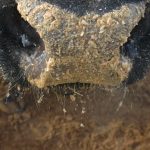VANCOUVER — Kristen Podolsky was amazed by soybean fields across Manitoba last summer, but not for the right reasons.
Podolsky, a Manitoba Pulse Growers Association production specialist, said she struggled to identify soybeans from the highway because many fields were inundated with volunteer canola.
“In some cases I wasn’t sure if it was a soybean field or a canola field,” she said in January following her presentation at Manitoba Ag Days.
“In Western Manitoba, I found it in 60 percent of fields.”
A soybean field loaded with volunteer canola may be visually offensive and worrisome, but the Roundup resistant weed isn’t always a threat to soybean production, said Paul Gregoire, a University of Manitoba graduate student in plant science.
Read Also

Canada told trade crisis solutions in its hands
Canadians and Canadian exporters need to accept that the old rules of trade are over, and open access to the U.S. market may also be over, says the chief financial correspondent for CTV News.
Gregoire, who spoke at the Weed Science Society of America annual meeting held in Vancouver Feb. 3-6, said volunteer canola typically doesn’t reach a density that substantially restricts yields.
“It seems like it is more of an aesthetic problem than an actual weed management problem.”
Gregoire set up plot experiments in Manitoba in 2012 and 2013 to assess the yield loss from volunteer canola in soybeans and identify a weed density level that warranted spraying.
He placed different concentrations of canola seed in the soybean plots to achieve a range of volunteer canola densities. Assuming a five percent yield loss as a threshold to take action, Gregoire found that volunteer canola densities of two to five plants per sq. metre might justify a herbicide treatment.
Rob Gulden, a University of Manitoba weed scientist, said there isn’t a magic number that should prompt growers to spray volunteer canola.
Researchers need to survey the densities of volunteer canola in soybean fields to assess the problem in Manitoba, he added.
“It is an eyesore, that’s for sure … (but) are we going to hit the economic threshold? Well, in some cases maybe not,” he said.
U of M scientists are studying volunteer canola in soybeans because a rotation of canola, wheat and beans has become a standard cropping system in parts of Manitoba.
As an informal part of his research, Gregoire also wandered into soybean fields last summer to count the number of intrusive plants per sq. metre. He showed a photograph of a soybean crop infested with volunteer canola during his presentation in Vancouver.
It looked like an agronomic problem at first glance, but the density of volunteer canola wasn’t particularly severe.
“This first patch (had) 0.6 plants per sq. metre,” he said. “I would say that’s not worth looking at for control.”
Another patch had 2.7 plants per sq. metre, which might warrant spraying, he said.

















